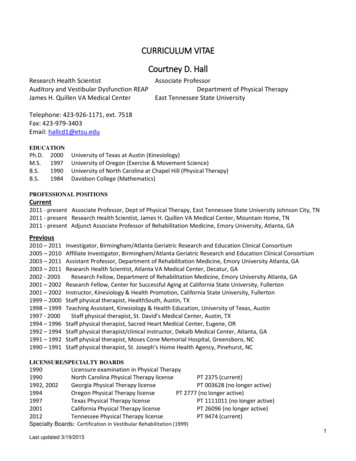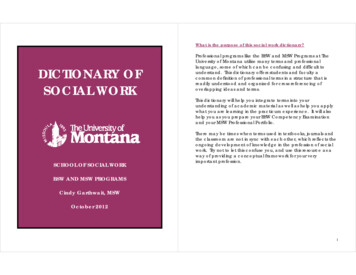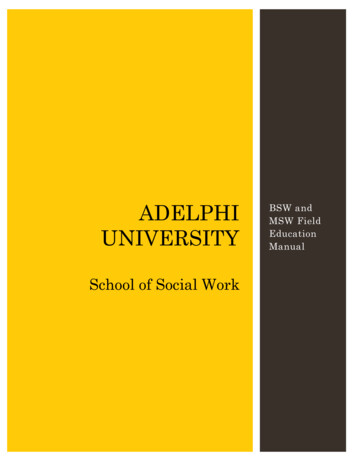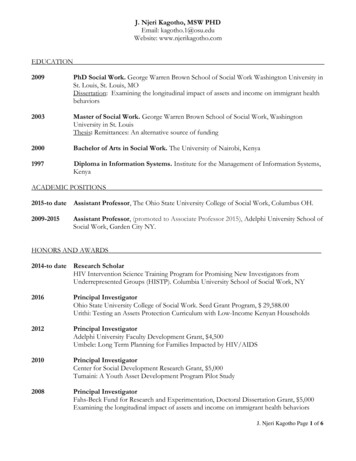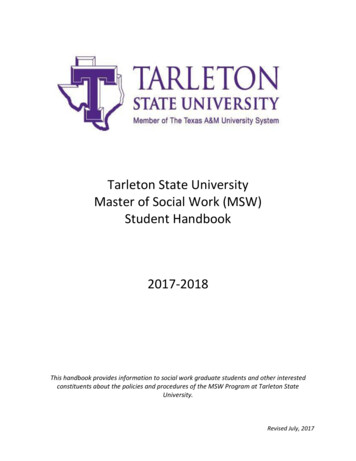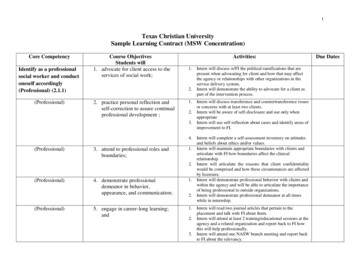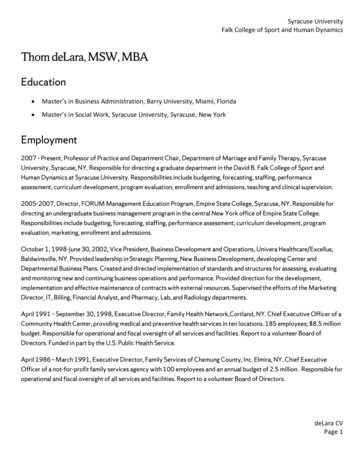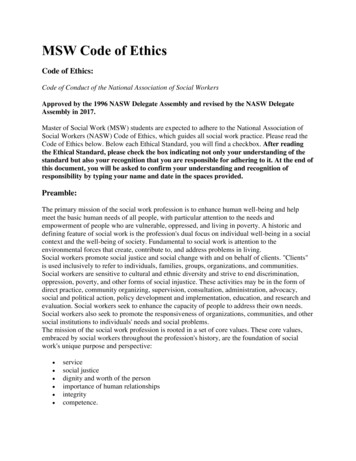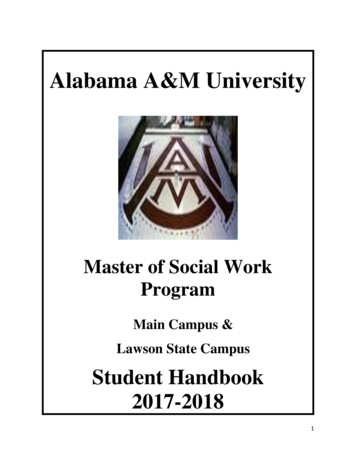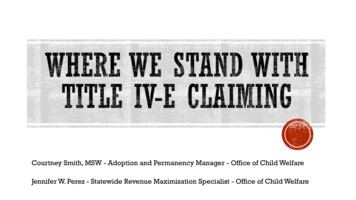
Transcription
Courtney Smith, MSW - Adoption and Permanency Manager - Office of Child WelfareJennifer W. Perez - Statewide Revenue Maximization Specialist - Office of Child Welfare
What is the Title IV-E Waiver? Allowed states to waive certain provisions ofRECAP: WHY THIS?WHY NOW?Title IV-E of the Social Security Act. Theseprovisions govern Federal programs relating tofoster care and other child welfare services. Allowed Federal Title IV-E foster care funds to beused for a wide variety of child welfare purposesrather than being restricted to eligible childrenin licensed foster care homes or institutions, as isthe case under federal law. On Waiver – Any Child in Any Placement Setting Off Waiver – Eligible Child in Eligible PlacementSetting
What does Title IV-E Fund? Foster Care Maintenance Payments: cost of and the cost ofproviding food, clothing, shelter, daily supervision, school supplies,child’s personal incidentals, liability insurance, reasonable travel tochild’s visitation, and reasonable travel to child's school at time ofremoval. Maintenance Adoption Subsidy Payments: monthly subsidy andnonrecurring expenses Administration Costs: case planning and management, eligibilitydeterminations, provider management, agency management. Training SACWIS/CCWIS Guardianship Assistance Program: monthly payments andnonrecurring expenses Candidates of Foster Care – Preventative Services (State Planpending approval)RECAP:WHY THIS?WHY NOW?
Waiver Expiration Date: September 2019 With the sun setting of the Title IV-E Demonstration Waiver, theDepartment has implemented ways to draw down additional fundingto support the state’s child welfare system while ensuring to maintaina quality level of enhanced services being offered to Floridacitizens. Projected 90 Million Deficit The Path Forward Initiative
Title IV-E ExtendedFoster Care (EFC) –Implemented 1/4/19Extension ofMaintenanceAdoption Subsidy(EMAS) –Implemented 1/4/19Extension ofGuardianshipAssistance Program(EGAP) –Implemented 7/1/19Expansion of FamilyFoster HomeLicensing (Level 1Foster Homes) –Implemented 4/12/19Title IV-E Candidacy –Implemented 10/1/19GuardianshipAssistance Program(GAP) – Implemented7/1/19Title IV-E EligibilityImprovements –Ongoing
Claims 1/2019 thruAnticipatedTitleIV-EExtended12/2019 5,178,699FosterCare (EFC)–ClaimingClaims 1/1/2020 thruImplemented1/4/19 7million6/2020 3,547,375
AnticipatedExpansion Claimingof FamilyAsof8/10/2020,20.19% 20million(projected40%Foster Home tive(Level 1 Foster Homes) plemented4/12/19I licensed)
TitleIV-E thruClaims10/1/2019Anticipated6/30/2020 31,349,248Candidacy–Claiming- ACF(StatePlanpendingImplemented 40millionapproval)10/1/19
Penetration Rateby QTR: –AnticipatedClaimingTitle IV-E EligibilityEnding 1012/31/2019- 53.36%millionEnhancements–Ending3/31/2020 - 62.68%(ImprovementofOngoingPenetrationRate- to72%)Ending 6/30/202062.96%
Eligibility and Reimbursability Valid Removal Sanctioned by: Voluntary Placement Agreement executed by parent andDepartment. Judicial finding of contrary to welfare (CTW) in first order. Child cannot remain with the person who was subject of CTWfinding.
5.90%Contrary to WelfareData as of 8.3.2020 for IV-E Ineligible children in care as of 4.30.2020.
Reasonable Effortsto Prevent RemovalFinding must bemade within 60 daysfrom when child wasremoved. If not,Ineligible for theremainder of theremoval episode.Reasonable Effortsto FinalizePermanency PlanPlacement & CareResponsibilityFinding must beMust be vested withmade within first 12the Department. Ifmonths from whennot, cannot claim forchild considered toany period in whichhave entered fosterthe court has notcare and ongoingmade finding.every 12 months. Ifnot, cannot claim untilfinding made.
5.02%28%RE Prevent Removal72%REOtherPreventRemovalReasonsData as of 8.3.2020 for IV-E Ineligible children in care as of 4.30.2020.
Child must have been Living With/Removed From a SpecifiedRelative who was subject of CTW finding. Financial Need Income cannot exceedConsolidated Need Standard(CNS) as established in 1996. Assets cannot exceed 10,000. Deprivation: child must bedeprived of parental support. Death Absence from home Incapacity Underemployment/Unemployment
7.94%Specified RelativeData as of 8.3.2020 for IV-E Ineligible children in care as of 4.30.2020.
28%AFDC Financial Need54.97%72%AFDCReasonsFinancialOtherData as of 8.3.2020 for IV-E Ineligible children in care as of 4.30.2020.Data as of 8.3.2020 for IV-E Ineligible children in care as of 4.30.2020.
28%48.86%72%AFDC DeprivationAFDCDeprivationOtherReasonsData as of 8.3.2020 for IV-E Ineligible children in care as of 4.30.2020.Data as of 8.3.2020 for IV-E Ineligible children in care as of 4.30.2020.
6.24%28%Unverified Financial Need72%UnverifiedOtherReasonsFinancialData as of 8.3.2020 for IV-E Ineligible children in care as of 4.30.2020.Data as of 8.3.2020 for IV-E Ineligible children in care as of 4.30.2020.
If child remains in care beyond 180 days, a judicialhearing must have occurred and a finding madethat continued placement is in the child’s bestinterest within the 180 period. If not, cannot claim IV-E funding for the remainderof the removal episode as of day 181.
0.76%28%VPA Best Interest72%180 DayBestReasonsInterestOtherData as of 8.3.2020 for IV-E Ineligible children in care as of 4.30.2020.
Must be in a licensed foster home or child careinstitution. Provider must meet criteria for full licensure. Safety Requirements must be met by the child’sfoster care provider. Background checks.
Family First Prevention Services Act The Act reforms the federal child welfarefinancing streams to provide services tofamilies who are at risk of entering the childwelfare system.FFPSA Aims to prevent children from entering fostercare by allowing federal reimbursement formental health services, substance usetreatment, and in-home parenting skill training. Seeks to improve the well-being of childrenalready in foster care by incentivizing states toreduce placement of children in congregatecare (group homes).
Prevention Activities Under Title IV-E Provides option for states to use title IV-E to provide upto 12 months of evidence-based mental health services,substance abuse treatment, and in-home parentingtraining to families at risk of entry of the child welfaresystem.FFPSAPART I Eligible candidates include children who can remainsafely at home with receipt of services, youth in fostercare who are parenting, or parents or caregivers whereservices are needed to prevent the child’s entry intofoster care. States must maintain a prevention plan for the child toremain safely at home that lists the services orprograms to be provided. Services must be trauma-informed and pre-approved onthe HHS Clearinghouse as promising, supported, wellsupported evidence-based practices (at least 50% oftotal expenditures must be for well-supportedpractices).
Enhanced Support Under Title IV-B Eliminates time limit for family reunificationFFPSAPART IIservices. Requires implementation of an electronicinterstate case processing system to expediteplacement of children in foster care by FY 2027. Provides 5 million in grants to states to assistwith implementation of processing system. Reauthorizes Regional Partnership Grantsthrough FY 2021.
FFPSAPART IIIMiscellaneous Establishes model foster care licensingstandards to support placement in a relativefoster family home. Require states to develop a statewide plan toprevent child abuse and neglect fatalities.
Ensuring The Necessity of a Placement That IsNot a Foster Family Home Title IV-E reimbursement for group homes will onlyFFPSAPART IVbe available for two weeks unless the child is in aqualified residential treatment program (QRTP), asetting that specializes in prenatal or parentingsupport, provides high-quality services to youth atrisk of or victims of sex trafficking, is a family-basedtreatment facility for substance abuse, or supervisedindependent living for youth over 18. A QRTP must include a trauma-informed treatmentmodel designed to meet the emotional andbehavioral needs of children as identified by anassessment within 30 days of the child’s placement(must be court approved within 60 days ofplacement). Provides states the option to delay the congregatecare provisions for up to two years while forfeitingreimbursement for prevention services.
Continuing Support for Child and FamilyServices Appropriated 8 million dollars for competitiveFFPSAPART Vgrants to support recruitment and retention ofhigh-quality foster families. Reauthorizes the Stephanie Tubbs Jones childwelfare services program, the Court Improvementprogram, and the John H. Chafee Foster CareIndependence Program. Expands until 23 Chaffee supports for states thatelected to extend eligibility for foster care to 21,and expands use of education and trainingvouchers for youth until 26.
FFPSAPART VIContinuing Incentives to States to PromoteAdoption and Legal Guardianship Reauthorizes Adoption and Legal GuardianshipIncentive Payment Program.
FFPSAPART VIITechnical Corrections Amends state plan requirement under Title IV-B todescribe ways to reduce length of time topermanency for children under the age of 5 and toaddress developmental needs of all vulnerablechildren under the age of 5 who receive IV-E or IVB services.
Ensuring States Reinvest Savings Resultingfrom Increases in Adoption AssistanceFFPSAPART VIII Delays Fostering Connections implementation offederal assistance for adoption of special needschildren. Authorizes children with special needs under 2years old to be eligible for assistance if they meetexisting requirements. Requires GAO study on state reinvestment of thesesavings because of this delay.
Utilizes Federal funds to support the array ofservices provided by local agencies (ChildrenServices Councils, Children Alliance, Tribes, State,County and City agencies and governments) tovulnerable children, youth and families involvedwith the child welfare system. Section 409.26731, Florida Statutes, establishes theauthority of the Department to certify publiclyappropriated, local funds as state match for eligibleTitle XIX and Title IV-E expenditures. Must have an Interagency Agreement with theDepartment. Local Match Initiative being developed to guideimplementation.LOCALMATCH
The 1994 Amendments to the Social Security Act authorize the Children’s Bureauto review state child and family services programs tor ensure compliance withthe requirements. Primary reviews occur at 3-year intervals. If State not found in “substantial compliance”, a Program Improvement Plan (PIP) isrequired. Upon completion of PIP, a Secondaryreview is conducted and 3-year intervalresumes. Financial payback (disallowance) associatedwith each Error Case and Improper 04Secondary15010%
Q&A
welfare services program, the Court Improvement program, and the John H. Chafee Foster Care Independence Program. Expands until 23 Chaffee supports for states that elected to extend eligibility for foster care to 21, and expands u
